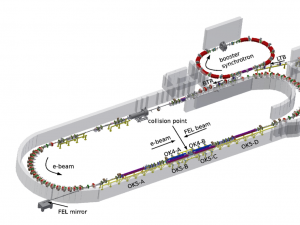Duke Free Electron Laser Laboratory
Triangle Universities Nuclear Laboratory (TUNL) operates its largest on-site accelerator facility with two major light sources: a storage ring Free-Electron Laser (FEL) and the High Intensity Gamma-ray Source (HIGS) at the Duke Free Electron Laser Laboratory (DFELL). These accelerator-based photon sources are housed in a 52,000 square-foot facility (the DFELL building). Duke FEL is a unique storage ring oscillator FEL with the world’s longest laser cavity (about 54 meters) with an active medium. This FEL can produce coherent photon beams in a wide range of wavelengths from IR (1060 nm) to VUV (190 nm), making it a premier FEL research facility. The HIGS is the highest-flux Compton gamma-ray source in the world. It generates polarized gamma-ray beams with energies from 1 to 100 MeV. The HIGS is a world-class gamma-ray facility for photo-nuclear physics research.
Researchers at TUNL are working in the following areas: research and development of compton gamma-ray sources; free-electron laser research; and accelerator and beam physics research and next-generation light source development
High Intensity Gamma-Ray Source (HIGS)
The High Intensity Gamma-Ray Source (HIGS), operated by the Triangle Universities Nuclear Laboratory, is capable of providing nearly mono-energetic, polarized gamma-ray beams with energies ranging from 1 to 100 MeV. This Compton gamma-ray source is essentially a photon-electron collider—the gamma-ray beams are generated by Compton backscattering via colliding the Free-Electron Laser (FEL) beam and the relativistic electron beam that also powers the FEL inside the FEL optical resonator. Typically, two circulating electron bunches, separated by one half circumference of the storage ring, are used for gamma-ray beam production. The accelerator driver for both FEL and HIGS is an electron storage ring (0.24—1.2 GeV), and its related injection system includes a linac pre-injector (0.16 GeV) and a booster injector (0.16—1.2 GeV). The maximum total intensity of the gamma-ray beam produced in the vicinity of 10 MeV is approximately 3 × 1010 g/s, making HIGS the highest flux Compton gamma-ray source ever built and operated.
LENA –The Laboratory for Experimental Nuclear Astrophysics
The Laboratory for Experimental Nuclear Astrophysics (LENA) is a world-class center for experimental and research on nuclear reactions and their importance in the evolution of stars and the origin of the elements. The Electron-Cyclotron Resonance (ECR) accelerator already produces the world’s most intense proton beams for low-energy measurements and is being upgraded to increase beam intensity. In late 2020-early 2021, the ECR accelerator will be joined by a 2-MV Singletron accelerator, a state-of-the-art machine, designed and constructed (by High Voltage Engineering Europa) specifically for LENA.
Current research topics include abundance anomalies in globular clusters and the evolution of the early galaxy, the production of the elements heavier than iron, the evolution of stars more massive than the sun and radioactive aluminum in the galaxy and in the early solar system.
LENA ECR Accelerator
The LENA electron-cyclotron resonance (ECR) accelerator produces the world’s most intense proton beams for measurements of nuclear reactions of astrophysical interest. Beam currents on target in excess of 4 mA have been achieved with energies up to 240 keV. In addition, the beam can be pulsed in order to reduce background events in our detectors. The ECR ion source is being upgraded to increase to beam currentsto at least 20 mA
Tandem Laboratory
Tandem van de Graaff Accelerator
The tandem laboratory hosts It hosts a model FN tandem Van de Graaff accelerator that has a maximum terminal voltage of 10 MV. After acceleration, beams of hydrogen, helium and heavy ions can be delivered to one of seven beam lines. In addition, a special feature of the facility is the ability to produce beams of nearly mono-energetic neutrons.
Enge Split-Pole Spectrometer
The Enge Split-Pole Spectrometer is designed for high-resolution spectroscopy of the products of nuclear reactions. It works by separating reaction products based on their momenta and bringing them to a focus where a detector measures position and particle type. The primary use of the Enge spectrometer is to analyze the properties of nuclei produced in stellar reactions, particularly those that cannot be measured directly at LENA.







